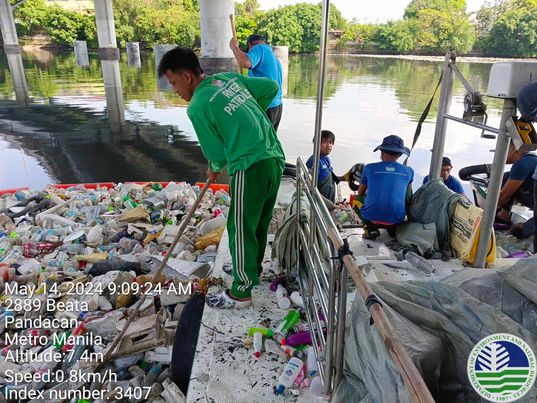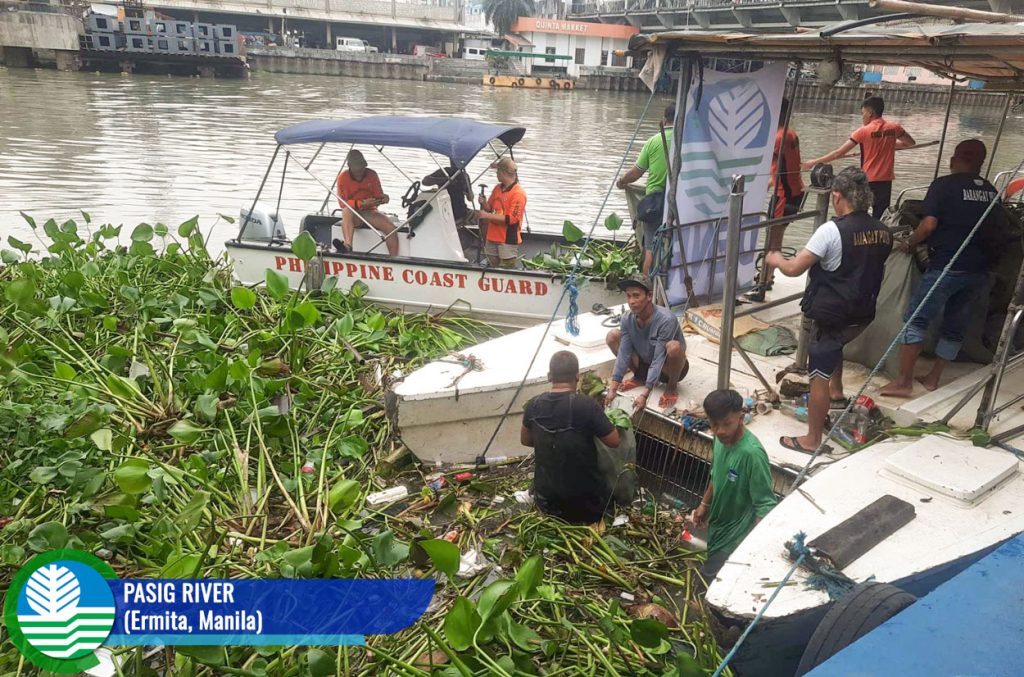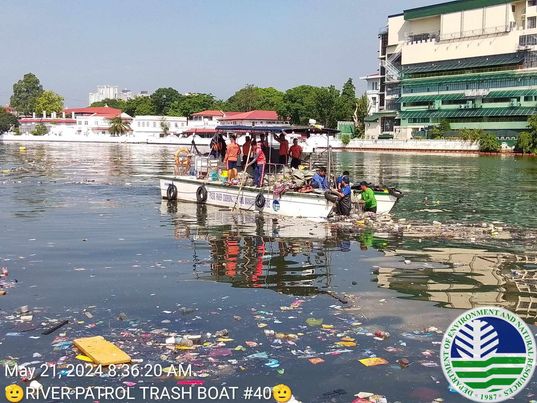 The Department of Environment and Natural Resources-Pasig River Coordinating and Management Office (DENR-PRCMO) has removed a total of 1,603.53 tons of mixed solid waste and water hyacinth from the Pasig River and its tributaries from January to May 15, 2024, in support to the ongoing Manila Bay Rehabilitation Program.
The Department of Environment and Natural Resources-Pasig River Coordinating and Management Office (DENR-PRCMO) has removed a total of 1,603.53 tons of mixed solid waste and water hyacinth from the Pasig River and its tributaries from January to May 15, 2024, in support to the ongoing Manila Bay Rehabilitation Program.
As of May 15, 2024, the PRCMO removed a total of 53,451 sacks of solid wastes and water hyacinths from the Pasig River System, which is equivalent to 1,603,530 kilograms or 1,603.53 tons.
The PRCMO regularly deploys its 163 Environmental Aides (EAs) known as “River Warriors” who are tasked to maintain the Pasig River System free from solid wastes and other floating debris through the conduct of clean-up operations on a daily basis, utilizing three (3) trash boats to aid in the collection of solid wastes and water hyacinths. Presently, the PRCMO’s clean-up operations cover the following priority areas: main Pasig River’s portions from Del Pan Bridge, Tondo, Manila to the San Juan River confluence in Sta. Ana, Manila; San Juan River; 25 minor tributaries such as esteros and creeks in Manila and Quezon City; and the two priority areas of BASECO and Parola, Tondo at the Pasig River’s mouth at Manila Bay. Engineering interventions such as trash barriers are also installed in these priority areas for easier and efficient collection.
 The PRCMO also works hand-in-hand with the Philippine Coast Guard (PCG) for the conduct of daily joint clean-up along the Pasig River’s portions situated in the Malacañang Restricted Area (MRA), as well as with other national government agencies (NGAs), local government units (LGUs), and the private sector for multi-sector clean-up activities and community clean-up drives.
The PRCMO also works hand-in-hand with the Philippine Coast Guard (PCG) for the conduct of daily joint clean-up along the Pasig River’s portions situated in the Malacañang Restricted Area (MRA), as well as with other national government agencies (NGAs), local government units (LGUs), and the private sector for multi-sector clean-up activities and community clean-up drives.
In addition, the PRCMO continuously monitors the Pasig River’s 47 minor tributaries and three (3) major tributaries, namely, the Marikina, San Juan, and Taguig-Pateros rivers, and maintains close coordination with other NGAs, the nine (9) LGUs along the Pasig River System, namely, the cities of Manila, Makati, Mandaluyong, Marikina, Pasig, Quezon City, San Juan, Taguig, and the municipality of Pateros, and their respective barangays. This is to harmonize efforts and facilitate dialogues with communities to address waste management concerns.
The PRCMO is eyeing to further improve clean-up and monitoring capabilities with the delivery of one (1) trash boat by June 2024 and procurement of additional trash boat and patrol boats for 2025. Additional boats aim to augment clean-up operations by covering more areas and thereby reducing the floating solid wastes along the Pasig River.
The full rehabilitation of the Pasig River System will complement the rehabilitation efforts in the Manila Bay Region, sustain the ecological services offered by Manila Bay and Laguna de Bay, promote tourism, and ensure seamless connectivity between road and water transport to address traffic woes in Metro Manila.
 Jacqueline A. Caancan, PRCMO Executive Director and Concurrent Director of Environmental Management Bureau, underscores the importance of collaboration and the active participation of all stakeholders in this undertaking, recognizing that the restoration of the Pasig River requires a collective effort and sustained commitment from everyone involved.
Jacqueline A. Caancan, PRCMO Executive Director and Concurrent Director of Environmental Management Bureau, underscores the importance of collaboration and the active participation of all stakeholders in this undertaking, recognizing that the restoration of the Pasig River requires a collective effort and sustained commitment from everyone involved.
“The revitalization of the Pasig River is a tall order. It is not only a matter of environmental conservation; it is a testament to our collective resolve to build a sustainable future for generations to come. By working together, we can transform the Pasig River into a thriving ecosystem and a source of pride for all Filipinos,” Caancan said.
To sustain the gains on the Pasig River rehabilitation, the DENR enjoins the public to continue to join hands in this endeavor and be “River Warriors” for the Pasig River who will lead the positive change towards a cleaner, greener, and more vibrant Pasig River. ###












